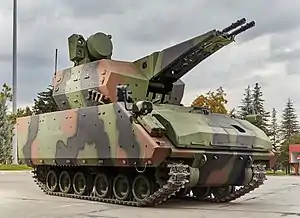KORKUT
The KORKUT is a Turkish all-weather-capable 35 mm self-propelled anti-aircraft gun (SPAAG) developed by Aselsan.[5][6][7][8][9]
| KORKUT | |
|---|---|
 | |
| Type | Self-propelled anti-aircraft gun |
| Place of origin | Turkey |
| Service history | |
| In service | 2016 – present[1] |
| Used by | Turkey |
| Wars | Second Libyan Civil War |
| Production history | |
| Designer | ASELSAN |
| Manufacturer | Aselsan and FNSS |
| No. built | 13 systems[3] |
| Variants | Aselsan GOKDENIZ |
| Specifications | |
| Length | 7 m (23 ft) |
| Width | 3.9 m (13 ft) |
| Height | 2.2 m (7.2 ft) |
| Caliber | 35 mm (1.38in) |
| Traverse | 360° |
| Rate of fire | 1100 rpm |
| Maximum firing range | 4 km |
Main armament | 35 mm dual-barrelled autocannon (with 400 rounds) |
Secondary armament | Stinger or Igla-S MANPADS |
| Maximum speed | 65 km/h (road) |
| References | [4] |
Designed to replace to aging M42A1 Duster systems of the Turkish Armed Forces, each Korkut system compromises of 1 command and control vehicle and 3 weapons platforms. Each weapon platform carries a twin 2×35 mm Oerlikon KDC-02 cannon, manufactured under licence by MKEK.[10] Each weapons system can fire up to 1100 rounds a minute up to a range of 4 km. The command and control vehicle has an effective radar range of 70 km. The Weapon System Vehicle and Command-and-Control Vehicle configurations designed under the Korkut Project are based on the FNSS ACV-30[11] and is fully amphibious and have the capability of propelling themselves in deep water and rivers.
The Turkish Armed Forces has ordered 40 weapons systems, deliveries are scheduled to complete in 2022.
Ammunition
The cannons can fire different types of 35×228 mm ammunitions including Aselsan made ATOM 35mm airburst ammunition.[6]
ATOM 35mm airburst ammunition ejects tungsten pellets at a predetermined distance. It is a smart ammunition which has a base fuse. Together with the ability of precise time counting and the capability of being programmed during firing by taking muzzle velocity into consideration automatically sets the fuse to detonate the round as it approaches a pre-set distance from the target.[12][13] Whilst a single pellet is too small to do major damage in itself, the accumulation of damage from multiple strikes is designed to destroy wings and control surfaces, sensors and aerodynamics, causing the target to crash. According to Aselsan, the ammunition is resistant against electromagnetic jamming.[12][13]
See also
References
- "Defense Ministry". Archived from the original on 31 December 2016. Retrieved 3 March 2020.
- "Letter dated 8 March 2021 from the Panel of Experts on Libya established pursuant to resolution 1973 (2011) addressed to the President of the Security Council". United Nations Security Council. 8 March 2021.
p.21, 143 and 159
- Yıldırım, Göksel. "Türk Silahlı Kuvvetlerine 10 yeni Korkut teslimatı". Anadolu Agency. Retrieved 3 March 2020.
- "ASELSAN KORKUT Alçak İrtifa Hava Savunma Sistemi". Retrieved 3 March 2020.
- "KORKUT Self Propelled Air Defense Gun System". Aselsan. Retrieved 26 July 2021.
- "KORKUT SSA" (PDF). Aselsan. Retrieved 26 July 2021.
- "KORKUT KKA" (PDF). Aselsan. Retrieved 26 July 2021.
- "KORKUT Self Propelled Air Defence Gun System - Army Technology".
- Administrator. "Korkut self-propelled air defense 35mm gun system vehicle technical data sheet specifications pictures video 11903175". www.armyrecognition.com.
- "İlk "KORKUT" sistemi teslim edildi". SVT | Savunma ve Teknoloji (in Turkish). Archived from the original on 2017-02-02. Retrieved 2021-07-26.
- "Korkut – Missile Defense Advocacy Alliance". Retrieved 2020-02-21.
- "ATOM 35mm Airburst Ammunition". Aselsan. Retrieved 8 July 2021.
- "ATOM" (PDF). Aselsan. Retrieved 8 July 2021.